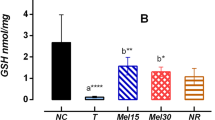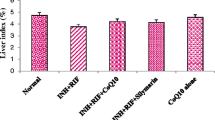Abstract
Objective: This study evaluated the influence of simultaneous administration of silymarin (SIL), a hepatoprotective and antioxidant agent, on the status of glutathione (GSH) and its metabolising enzymes in the liver tissue of rats treated with antitubercular drugs, i.e. isoniazid (INH), rifampicin (RIF) and pyrazinamide (PYR).
Methods: Male Wistar albino rats (n = 24) were randomly divided into four groups. Group I received saline as they served as controls. Group II rats were administered antitubercular drugs (INH 25mg/kg + RIF 50mg/kg + PYR 140 mg/kg orally) daily for 45 days. Group III animals were treated with SIL (50 mg/kg orally) simultaneously with the antitubercular drugs for the same period. Group IV animals were treated with SIL alone. The status of GSH, glutathione peroxidase (GPx), glutathione reductase (GR) and glutathione-s-transferase (GST) in liver tissue was evaluated at the end of the study.
Results: Administration of antitubercular drugs caused a significant decrease (p < 0.001) in the status of GPx, GST and GR and of non-enzymic (GSH) antioxidants in liver tissue when compared with saline-treated control rats. Simultaneous treatment of SIL with antitubercular drugs completely prevented decreases in the levels of all the above parameters. Treatment with SIL alone enhanced the activities of GST (p < 0.001) and GPx (p < 0.05) and did not alter glutathione levels compared with control.
Conclusion: A fall in the status of glutathione and its conjugating enzymes upon administration of antitubercular drugs denotes an impairment of the antioxidant defence mechanism. Simultaneous administration of SIL afforded complete protection of the liver against this abnormality, an effect that could have been due to the strong antioxidant properties of SIL.

Similar content being viewed by others
References
Petri Jr WA. Antimicrobial agents: drugs used in the chemotherapy of tuberculosis, Mycobacterium avium complex disease and leprosy. In: Hardman JG, Limbird LE, editors. Goodman and Gilman’s the pharmacological basis of therapeutics. New York: McGraw Hill Medical Publishing Division, 2001: 1272–94
Mitchell JR, Long MW, Thorgeirsson UP, et al. Acetylation rates and monthly liver function tests during one year of isoniazid preventive therapy. Chest 1975; 68: 181–90
Barlow PB, Black M, Brummer DL, et al. Preventive therapy of tuberculous infection. Am Rev Resp Dis 1974; 110: 371–4
Rubin B, Burke JC. Absorption, distribution and excretion of isoniazid (Nydrazide) in the dog. J Pharmacol 1953; 107: 219–24
Karthikeyan S, Krishnamoorthy MS. Effect of sub acute administration of isoniazid and pyridoxine on lipids in plasma, liver and adipose tissues in the rabbits. Drug Chem Toxicol 1991; 14 (3): 293–03
Sarich TC, Zhou T, Adams SP, et al. A model of isoniazid induced hepatotoxicity in rabbits. J Pharmacol Toxicol Methods 1995; 34: 109–16
Karthikeyan S. Isoniazid and rifampicin treatment on phospholipids and their sub-fractions in liver tissue of rabbits. Drug Chem Toxicol 28 2005; 28 (3): 273–80
Raisfeld IH. Drug-induced liver disease: guinea pig model for isoniazid (INH) hepatitis-the predictive value of urinary D-glucaric acid excretion [abstract]. Gastroenterology 1975; 69: 854
Thomas BH, Whitehouse LW, Zeitz W. Metabolism of (14C) acetylisoniazid and (14C) acetyl hydrazine by rat and rabbit. Fundam Appl Toxicol 1984; 4: 646–53
Colice GL. Decision analysis, public health policy, and isoniazid chemoprophylaxis for young adult tuberculin skin reactors. Arch Intern Med 1990; 150: 2517–22
Flora K, Hahn M, Rosen H, et al. Milk thistle (Silybum marianum) for the therapy of liver diseases. Am J Gastroenterol 1998; 93: 139–43
Valenzuela A, Aspillaga M, Vial 6S, et al. Selectivity of silymarin on the increase of the glutathione content in different tissues of the rat. Planta Med 1989; 55: 420–2
Morazzoni P, Bombardelli E. Silybum marianum (Carduus marianus). Fitoterapia 1995; 66: 3–42
Shan X, Aw TY, Jones DP. Glutathione dependent protection against oxidative injury. Pharmacol Ther 1990; 47: 61–71
Ellman GL. Tissue sulfhydryl groups. Arch Biochem Biophys 1959; 82: 70–7
Beutler E, Duron O, Kelly BM. Improved method for the determination of blood glutathione. J Lab Clin Med 1963; 61: 882–8
Habig WH, Pabst MJ, Jakoby WB. Glutathione S transferases: the first enzymatic step in mercapturic acid formation. J Biol Chem 1974; 249: 7130–9
Mize CE, Langdon RG. Hepatic glutathione reductase: I. Purification and general kinetic properties. J Biol Chem 1962; 237: 1589–95
Rotruck JT, Pope AL, Ganther HE, et al. Selenium: biochemical role as a component of glutathione peroxidase. Science 1973; 179: 588–90
Lowry OH, Rosebrough NJ, Farr AL, et al. Protein measurement with the Folin phenol reagent. J Biol Chem 1951; 193: 265–75
Sodhi CP, Rana SV, Mehta SK, et al. Study of oxidative stress in isoniazid-rifampicin induced hepatic injury in young rats. Drug Chem Toxicol 1997; 20 (3): 255–69
Tasduq SA, Peerzada K, Koul S, et al. Biochemical manifestations of anti-tuberculosis drugs induced hepatotoxicity and the effect of silymarin. Hepatol Res 2005; 31: 132–5
Nelson SD, Mitchell JR, Timbrell JA, et al. Isoniazid and iproniazid: activation of metabolites to toxic intermediates in man and rats. Science 1976; 193: 901–3
Timbrell JA, Mitchell JR, Snodgrass WR, et al. Isoniazid hepatotoxicity: the relationship between covalent binding and metabolism in vivo. J Pharmacol Exp Ther 1980; 213: 364–9
Whitehouse LW, Tryphonas L, Paul CJ, et al. Isoniazid-induced hepatic steatosis in rabbits: an explanation for susceptibility and its antagonism by pyridoxine hydrochloride. Can J Physiol Pharmacol 1983; 61 (5): 478–87
Sarich TC, Adams SP, Zhou T, et al. Isoniazid induced hepatic necrosis and steatosis in rabbits: absence of effect of gender. Can J Physiol Pharmacol 1997; 75: 1108–11
Zilly W, Breimer DD, Richter E. Induction of drug metabolism in man after rifampicin treatment measured by increased hex-obarbital and talbutamide clearance. Eur J Clin Pharmacol 1975; 9: 219–27
Van Den Broke JM, Ten Wolde-Kraawinkel, Breimer DD. The effect of rifampicin on the oxidative metabolism of xenobiotics in rat, hamster, guinea pig and mice, with emphasis on the NMRI mouse. Develop Biochem 1980; 3: 235–8
Pessayre D, Bentata M, Degott C, et al. Isoniazid-rifampin fulminant hepatitis: a possible consequence of the enhancement of isoniazid hepatotoxicity by enzyme induction. Gastro-enterology 1977; 72: 284–9
Bistritzer T, Barzilay Z, Jonas A. Isoniazid-rifampicin induced fulminant liver disease in an infant. J Pediatr 1980; 97: 480–2
Meister A. On the enzymology of amino acid transport. Science 1973; 180: 33–9
Sies H, Ketterer B. Glutathione conjugation: mechanisms and biological significance. London: Academic Press, 1988
Winston GW, DiGiulio RT. Prooxidant and antioxidant mechanism in aquatic organisms. Aquat Toxicol 1991; 19: 137–61
Acknowledgements
The authors thank the Department of Science and Technology, New Delhi, India, for financial assistance in carrying out this work. The authors gratefully acknowledge the Central Drug Research Institute, Lucknow, India, for providing silymarin free of charge. We also thank Medi Span, Chennai, India, for providing rifampicin and pyrazinamide free of charge.
The authors have no potential conflicts of interest that are directly relevant to the contents of this manuscript.
Author information
Authors and Affiliations
Corresponding author
Rights and permissions
About this article
Cite this article
Victorrajmohan, C., Pradeep, K. & Karthikeyan, S. Influence of Silymarin Administration on Hepatic Glutathione-Conjugating Enzyme System in Rats Treated with Antitubercular Drugs. Drugs in R D 6, 395–400 (2005). https://doi.org/10.2165/00126839-200506060-00007
Published:
Issue Date:
DOI: https://doi.org/10.2165/00126839-200506060-00007




